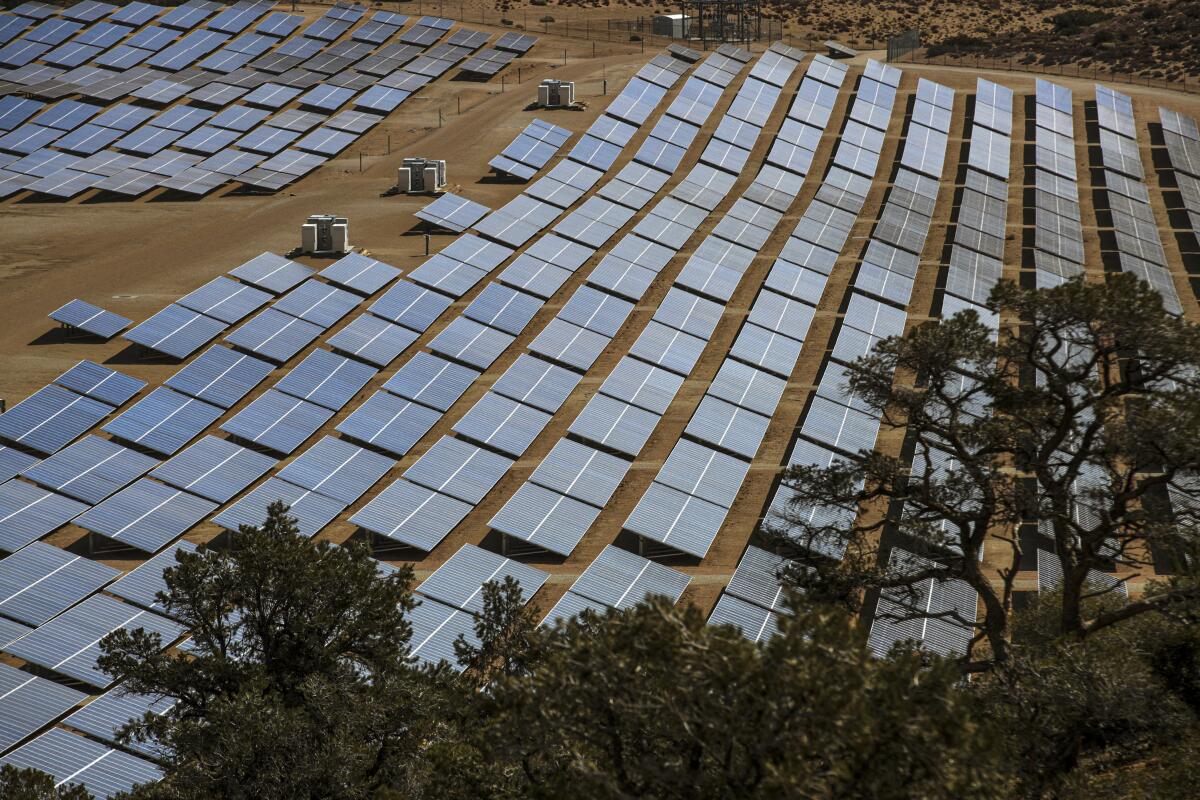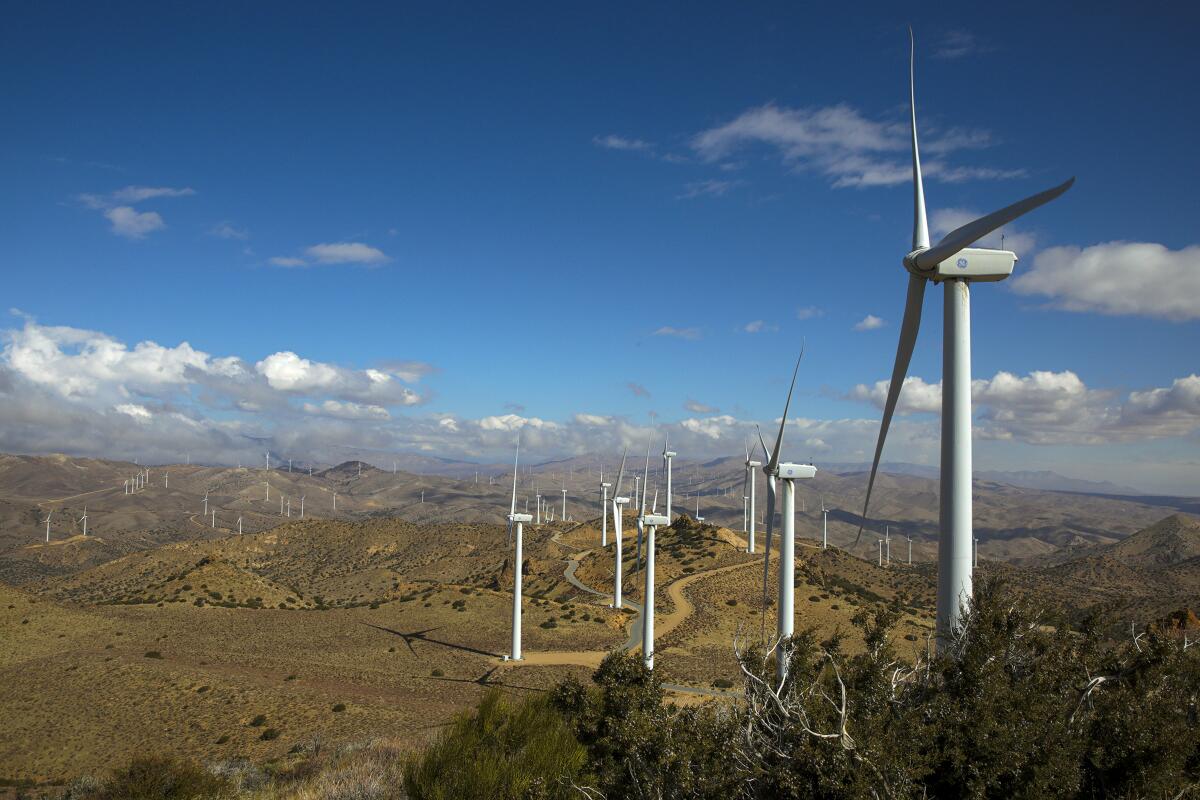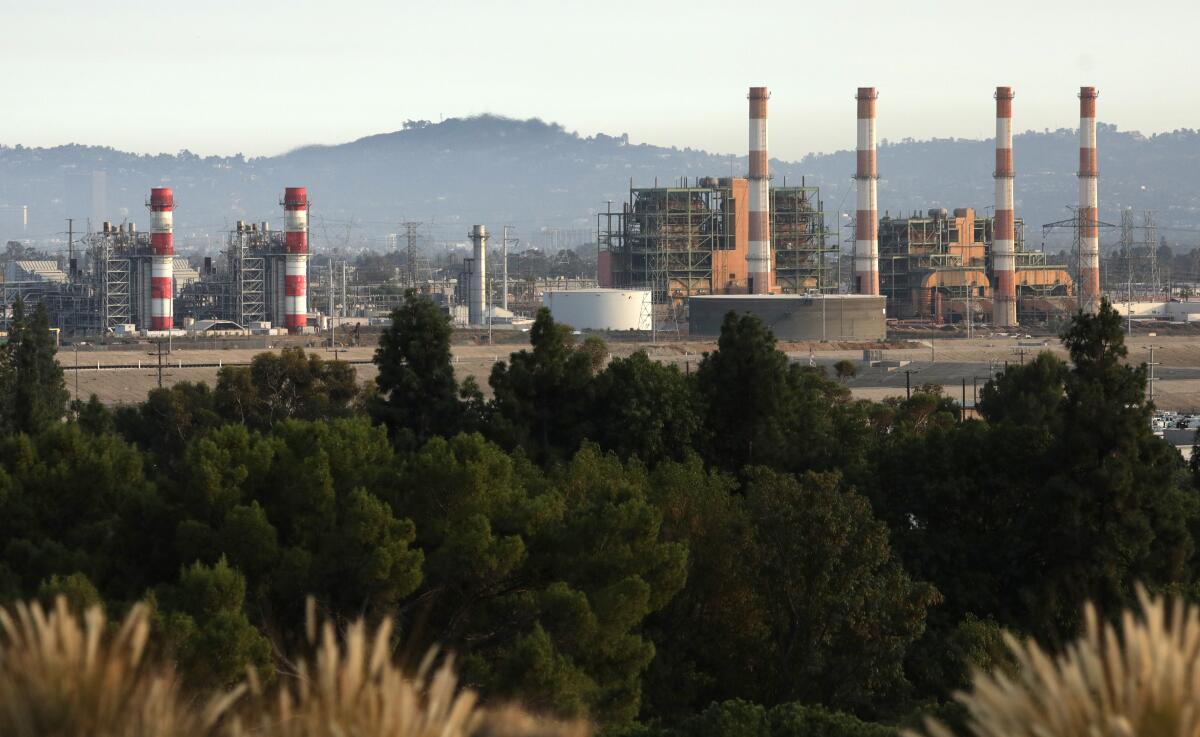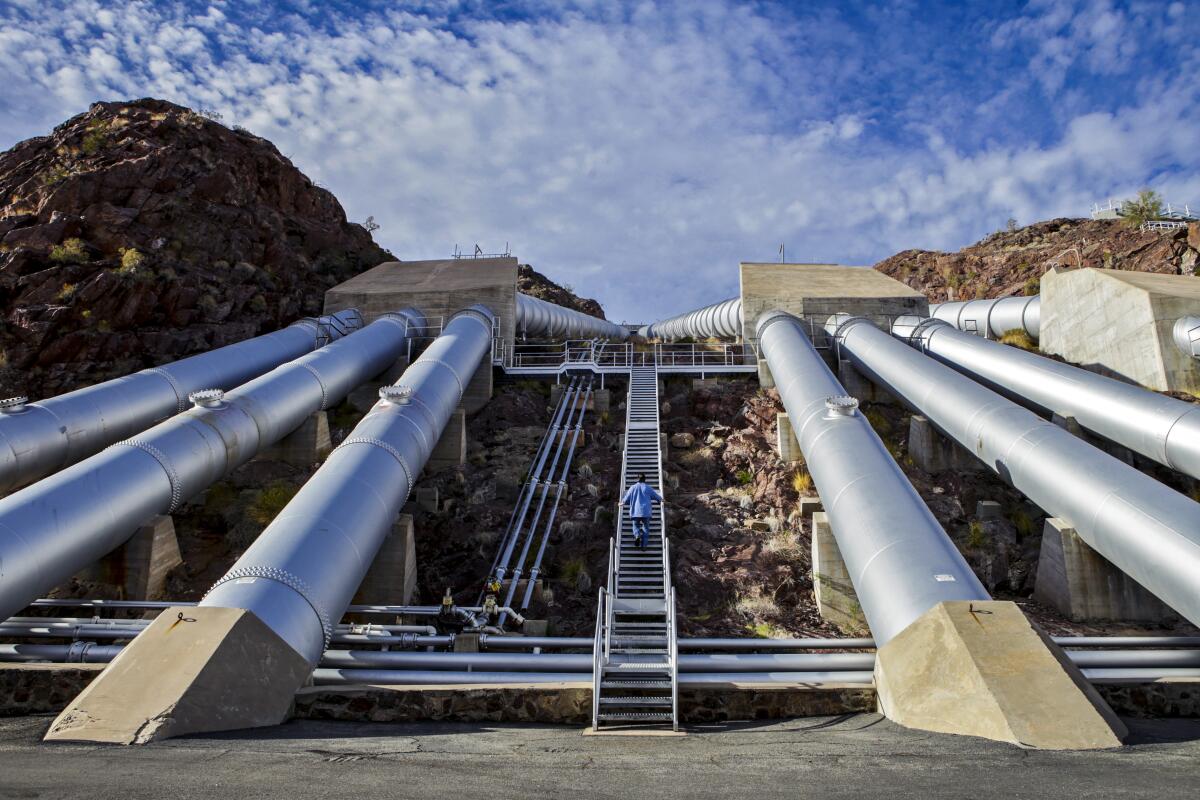California’s climate challenge: Move fast, don’t break things

- Share via
This is the March 25, 2021, edition of Boiling Point, a weekly newsletter about climate change and the environment in California and the American West. Sign up here to get it in your inbox.
In the early days of Facebook, Mark Zuckerberg had a motto: “Move fast and break things.” It became a Silicon Valley mantra, describing a culture of shaking up the established order without worrying too much about collateral damage.
It’s easy to change the world when you don’t care who gets hurt. Which is why what California is trying to do on the electric grid is so hard: Move very, very fast, without breaking a single damn thing.
I’m talking about the state law mandating 100% clean power by 2045, and specifically about a 179-page report released last week by state officials, outlining different strategies for getting there. But the point applies more broadly to why fighting climate change is so tricky, even in a place like California. You’ve got to keep the lights on. You’ve got to keep energy bills affordable. You’ve got to think carefully about jobs, and land use, and air pollution in communities of color. These are not easy problems to solve.
And if you get any of it wrong, the whole endeavor might blow up in your face.
The Los Angeles Department of Water and Power — which operates its own electric grid separate from the rest of the state — just released one of the most comprehensive studies ever of how to put all the pieces together. The first-of-its-kind analysis, conducted by the National Renewable Energy Laboratory, found that L.A. can achieve 100% clean energy a decade early, in line with President Biden’s 2035 goal — without causing blackouts or disrupting the economy.
Biden’s energy secretary, Jennifer Granholm, said Wednesday that the study would “provide a road map for other cities, other states to follow. And if we do this right, it won’t just be an energy transformation — it will be an economic revolution.”
“America’s second-largest city can get to 100% clean electricity by 2035, and you can do it with a grid that is going to be reliable and resilient,” Granholm told reporters. “And in fact, if you start right now, you’re going to get most of the way there by 2030.”
Toward a more sustainable California
Get Boiling Point, our newsletter exploring climate change, energy and the environment, and become part of the conversation — and the solution.
You may occasionally receive promotional content from the Los Angeles Times.
For more details on L.A.’s road map to fighting climate change, read my story in The Times.
The statewide report outlining paths to 100% clean power, which was led by the California Energy Commission, is less exhaustive by comparison. Still, it’s crucial reading for anyone who cares about the future habitability of the Golden State, and the world.
So let’s take a closer look.
One key finding is that meeting the 100% mandate will require building clean-energy facilities at unprecedented speeds.
How unprecedented?
California has never built more than 2.7 gigawatts of non-rooftop solar power or 1 gigawatt of wind power in a year. It will now need to build that much solar and wind every year for the next 25 years, on average, along with 2 gigawatts of battery storage annually — and possibly more, if we assume every natural gas plant is eventually shut down (more on that in a minute).
Finding the land for all that infrastructure won’t be easy. I’ve written about opposition to solar and wind farms from rural landowners and conservationists, and I expect those kinds of conflicts to grow and intensify as California and other states work to meet their climate goals. Columbia University’s Sabin Center for Climate Change Law released a report last month that found local governments in 31 states have adopted at least 100 ordinances blocking or restricting new renewable energy facilities.

David Hochschild, who chairs the California Energy Commission, is hopeful the Biden administration will make it easier to build clean-energy infrastructure on public lands, at least. He noted that Janea Scott, who served with him on the Energy Commission for eight years, is now a counselor to Interior Secretary Deb Haaland.
“We think we’ll have a great partnership there,” Hochschild said.
Another key finding is that solar, wind and batteries won’t be enough to replace fossil fuels.
The importance of a more diverse set of renewable resources isn’t surprising — you’ve all heard about how the sun doesn’t shine and the wind doesn’t blow all the time — although the ideal long-term mix is hard to predict, with technologies such as offshore wind and renewable hydrogen still relatively nascent. However that shakes out, the report concludes that complying with the state’s 100% clean-energy law is achievable, with a total annual cost of about $4.5 billion in additional spending.
But what does complying with the law mean, exactly? Surprisingly, it’s up for debate.
Senate Bill 100, signed by then-Gov. Jerry Brown in 2018, says zero-carbon power sources must “supply 100% of all retail sales of electricity to California end-use customers and 100% of electricity procured to serve all state agencies by December 31, 2045.”
That may sound straightforward, but apparently it’s not. State officials have honed in on the “retail sales” bit, interpreting it to mean that the actual generation of electricity to serve Californians doesn’t have to be 100% climate-friendly. Electricity lost during the journey from power plant to customer, for instance — known as “line loss” — isn’t counted toward retail sales.
That means utilities could be allowed to burn gas without violating the law. Clean power sources would account for just 90% of electricity generation in 2045 under the “core” scenario studied by state officials, with gas making up the rest.

Throw in “unspecified imports” from other states — which would also be allowed — and the electric grid would contribute to the release of 24 million metric tons of carbon dioxide in 2045. That would be a nearly two-thirds reduction from 2018 levels, but still a lot of carbon for the year by which California is supposed to achieve net-zero emissions. And it would actually be a lot higher once you account for the millions of electric vehicles — and possibly millions of all-electric buildings — that might exist by that time.
I asked L.A. City Councilmember Kevin de León — who wrote Senate Bill 100 when he was in the state Legislature — if he agrees with that interpretation of the law, which Los Angeles officials have also endorsed. He didn’t answer directly.
“I’ve always been very clear from the onset that I wasn’t picking any winners or losers with regards to what type of renewable or zero-carbon technology would be needed to create that bridge, that pathway to 100%,” de León said. “On a side note, the president of Southern California Gas has asked for a meeting with me to discuss the very topic that you have put forth.”
State officials also analyzed a “no combustion” pathway to the 100% goal where natural gas would be eliminated. They found it to be potentially achievable but more expensive, with annual costs $8 billion higher than the scenario that includes gas.
Hochschild said he’s optimistic that advances in battery storage, offshore wind and other technologies will eventually make it possible to phase out gas, telling me, “time is our friend on these things.” He had a similar response when I asked him about speeding up the 100% clean-energy target date to 2035, which was also analyzed in the state’s report.
“I think it’s the right decision by President Biden,” he said. “Our state has been on fire for three years in a row, and we’re in a climate emergency. Does it mean we have to do more faster and reevaluate? Absolutely.”
Gov. Gavin Newsom made similar comments as record-breaking wildfires raged last year. Since then, I’ve written a whole bunch of stories questioning whether the governor is living up to his pledge to move faster on climate.
The California Public Utilities Commission in particular has sounded alarm bells of caution, warning that building too much clean-energy infrastructure in the next few years could cause electricity rates to skyrocket. The state’s new report on pathways to 100% seems to reflect that mentality, backloading most of the dramatic clean-energy build-out in the years after 2027.
I asked Hochschild if there’s such a thing as moving too fast. He responded carefully.
“The risk of moving too fast is that you will overspend, and you may spend on some technologies that don’t perform,” he said. “But when you understand the nature of the benefit that’s at stake, I think it’s a greater threat to move too slowly. “
Move fast, and don’t break things. That’s the balance Los Angeles is trying to strike, California is trying to strike, and governments around the world ultimately must strike. The stakes could not be higher.
On that note, here’s what’s happening around the West:
TOP STORIES

Let’s start with a bona fide good news story: U.S. bald eagle populations are recovering spectacularly, and we know that in part because of citizen scientist observations recorded through the eBird app. My colleague Anna M. Phillips reports that the number of eagles in the lower 48 states has soared to more than 300,000 — a dramatic turnaround from the 1960s, when fewer than 500 nesting pairs remained. Interior Secretary Deb Haaland credits the recovery to the federal Endangered Species Act.
Much like with climate change, oil companies knew decades ago that their air pollution was harmful to people’s health, a Guardian investigation found. Here’s the story from Oliver Milman. The industry eventually stopped denying climate change, but it still largely rejects the science linking its pollution to serious health problems. In California, meanwhile, oil and gas regulators are largely failing to enforce health and safety rules despite years of criticism, Janet Wilson reports for the Desert Sun and ProPublica.
In one of his final acts as California’s attorney general, Xavier Becerra joined lawsuits against two proposed housing developments in rural San Diego County, citing the risk of wildfires. More details here from Joshua Emerson Smith at the San Diego Union-Tribune, who reports that fire safety and the need for more housing are increasingly coming into conflict across the state. (Becerra was confirmed by the U.S. Senate last week as President Biden’s Health and Human Services secretary.)
POLITICAL CLIMATE
A Silicon Valley Democrat and longtime clean-energy supporter is leading a congressional investigation into the Texas power outages, to the consternation of certain Texans. My colleague Evan Halper explored the political fallout from the blackouts, in a story that includes this observation from UT Austin’s Mike Webber: “If we actually did connect Texas to the Western power grids, we could sell you Californians a lot of wind and solar power for a handsome profit.” In related news, the newly appointed chair of the Texas Public Utility Commission has already resigned after apologizing to investors for the “uncertainty” around whether they can keep their giant profits from last month’s cold snap, Loren Steffy reports for Texas Monthly.
The White House is preparing a $3-trillion infrastructure and climate package, and California mass transit is poised to benefit, if Congress goes along. Projects that could receive funds include the long-awaited bullet train, an electrified high-speed rail line from Anaheim to Burbank, and improvements to the L.A.-to-San Diego line that would cut travel time, Ralph Vartabedian writes in The Times. The more easily people can take trains to get around, the less automobile pollution we’ll all be spewing.
Oil and gas leases were so cheap during the last year of the Trump presidency that a Burmese immigrant bought hundreds and has been flipping them at a big profit to unsuspecting fellow immigrants. This is the kind of story you have to read to believe; kudos to Reuters’ Nichola Groom for piecing it together. A lot has changed at the Interior Department under President Biden, with Secretary Deb Haaland hosting a public forum today seeking input on revamping the federal oil and gas program.
WATER IN THE WEST

The water outlook as we enter spring 2021 is getting bleaker by the week. In California, officials are lowering their forecast of water deliveries to cities and farms, telling State Water Project customers to expect just 5% of their contracted supplies this year, Dale Kasler reports in the Sacramento Bee. In Nevada, a town east of Reno is suing the federal government over a plan to end leaks from an irrigation canal, saying it’s come to depend on those leaks to feed the underground aquifer it taps for drinking water, per the AP’s Scott Sonner. And in Montana, the people of Colstrip are totally dependent on a local coal plant to pipe in their drinking water and don’t know what they’ll do if and when the plant closes, Tom Lutey reports in the Billings Gazette.
The Times’ Adam Elmahrek has been reporting on allegations of sexual harassment at the Metropolitan Water District of Southern California. This week he’s got a masterfully told story about life in the remote desert towns along the Colorado River Aqueduct, and what can happen when an allegedly dangerous man is in charge. In other desert news, environmental groups are suing the federal government over a last-minute Trump administration move to support the Cadiz water project, Nathan Solis reports in Courthouse News. For background on Cadiz, check out this 2012 story by The Times’ Bettina Boxall.
Off-road vehicles will no longer be allowed at Ocean Dunes, an ecologically fragile spot along the California coast. The California Coastal Commission approved the ban, which will take effect within three years, my colleague Louis Sahagún reports.
THE ENERGY TRANSITION
More than five years after the Aliso Canyon gas leak, a comprehensive study of the health effects is still in its early stages. More details here from Elizabeth Chou at the L.A. Daily News, who explains how members of the public can offer feedback to county officials on the study’s goals and priorities. The slow pace has frustrated and angered residents of Porter Ranch, the neighborhood that bore the brunt of the record-breaking methane leak from the Southern California Gas Co. facility.
Clean-energy advocates are criticizing the California Public Utilities Commission, saying the agency has been too favorable to natural gas as it lines up power supplies to help keep the lights on this summer. The Orange County Register’s Martin Wisckol explored what’s going on. The San Diego Union-Tribune’s Rob Nikolewski also notes that one of San Diego Gas & Electric’s new contracts is with the gas-fired Sentinel plant north of Palm Springs, which I used to write about when I lived in the desert.
“Your former boss can threaten and scare and bully and defame you, but then you’re stuck in private arbitration.” That’s one expert’s take on an appeals court ruling that a former Tesla engineer can’t pursue a defamation lawsuit against the company because of an arbitration agreement that was part of her employment contract. Here’s the story from The Times’ Russ Mitchell.
ONE MORE THING

Here’s a fun bit of history: The concept of a personal “carbon footprint” was originally popularized by the oil company BP, as part of a public relations campaign designed to shift responsibility for confronting the climate crisis from corporate polluters to you and me. That doesn’t necessarily mean it’s a waste of time or energy for individuals to work toward a lower-carbon lifestyle, but it does serve as a reminder that the forces holding back systemic change are a lot bigger than your personal decisions.
With that said, L.A. Times columnist David Lazarus writes that food waste “is one of the most urgent issues of our time,” in part because of the large amounts of energy used to produce and transport meat, vegetables and other foodstuffs. To the extent that we can avoid buying food we don’t need, we can keep a great deal of carbon out of the atmosphere.
The Jewish holiday of Passover starts this weekend. I’ll commit to not procuring more matzo than is absolutely necessary.
We’ll be back in your inbox next week. If you enjoyed this newsletter, please consider forwarding it to your friends and colleagues.




